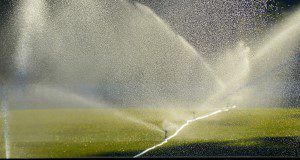Abstract
In the United States, landscape irrigation often consumes 50% or more of residential water used, and aesthetics may take preference over water-conserving elements in the landscape. Other factors such as perceived social norms and homeowners' association (HOA) regulations also impact water conservation behaviors. Binary logistic regression estimated the impact of aesthetics, perceived social norms, and HOA regulations on water conservation intentions. Findings revealed that when individuals placed a higher-than-average value on aesthetics and perceived stronger social support for conservation, home irrigation users had greater intent to conserve water. This new 4-page publication of the UF/IFAS Department of Agricultural Education and Communication was written by Amanda D. Ali and Laura A. Sanagorski Warner.
http://edis.ifas.ufl.edu/wc331
References
Ajzen, I. (1988). Attitudes, personality, and behavior. Milton Keynes, UK: Open University Press.
Hayden, L., Cadenasso, M. L., Haver D., & Oki, L. R. (2015). Residential landscape aesthetics and water conservation best management practices: Homeowner perceptions and preferences. Landscape and Urban Planning, 144, 1-9. doi:10.1016/j.landurbplan.2015.08.003 https://doi.org/10.1016/j.landurbplan.2015.08.003
Hurd, B. H. (2006). Water conservation and residential landscapes: Household preferences, household choices. Journal of Agricultural and Resource Economics, 31(2), 173-192. Retrieved from http://aggie-horticulture.tamu.edu/faculty/hall/EllisonChair/Water/Water%20conservation%20and%20residential%20landscapes.pdf
Martin, C. A., Peterson, K. A., & Stabler, L. B. (2003). Residential landscaping in Phoenix, Arizona, U.S.: Practices and preferences relative to covenants, codes, and restrictions. Journal of Arboriculture, 29(1), 9-17. doi:10.1145/782941.782945 https://doi.org/10.1145/782941.782945
Nassauer, J. (1988). The aesthetics of horticulture: Neatness as a form of care. HortScience, 23(6), 973-977. Retrieved from https://deepblue.lib.umich.edu/handle/2027.42/49345 https://doi.org/10.1002/crat.2170230804
Nassauer, J., Wang, Z., & Deyrell, E. (2009). What will the neighbors think? Cultural norms and ecological design. Landscape and Urban Planning, 92(3-4), 282-292. doi:10.1016/j.landurbplan.2009.05.010 https://doi.org/10.1016/j.landurbplan.2009.05.010
Nielson, L., & Smith, C. L. (2005). Influences on residential yard care and water quality: Tualatin watershed, Oregon. Journal of the American Water Resources Association, 41(1), 93-106. doi:10.1111/j.1752-1688.2005.tb03720.x https://doi.org/10.1111/j.1752-1688.2005.tb03720.x
Schultz, P. W. (1998). Changing behavior with normative feedback interventions: A field experiment on curbside recycling. Basic and Applied Psychology 21(1), 25-36. doi:10.1207/s15324834basp2101_3 https://doi.org/10.1207/s15324834basp2101_3
Wentz, E. A., Rhode, S., Li, X., Tellman, E. M., & Turner II, B, L. (2016). Impact of homeowner association (HOA) landscaping guidelines on residential water use. Water Resources Research, 52, 3373-3386. doi:10.1002/2015WR018238 https://doi.org/10.1002/2015WR018238
Zmyslony, J., & Gagnon, D. (1998). Residential management of urban front-yard landscape: A random process? Landscape and Urban Planning, 40(4), 295-307. Retrieved from http://www.sciencedirect.com/science/journal/01692046/40 https://doi.org/10.1016/S0169-2046(97)00090-X
Unless otherwise specified, articles published in the EDIS journal after January 1, 2024 are licensed under a Creative Commons Attribution-NonCommercial-NoDerivs 4.0 International (CC BY-NC-ND 4.0) license.

